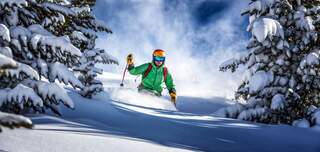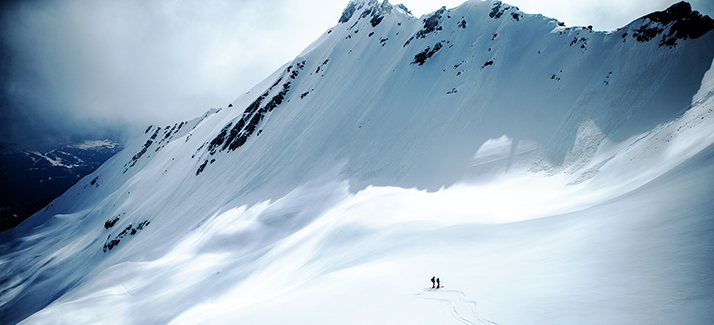RIDING THE POWDER: BEGINNERS TOP TIPS

Skiing powder should be like skiing on clouds. Soft, untouched snow helps skis glide over the surface; powder, however, can be a daunting prospect for a beginner, but there many who attempt the off piste before they master the techniques. To make sure you have all the skills you need to head into the unknown we're sharing some of our top tips for riding powder for the first time.

Know the Basics
Before you head out in search of fresh powder, it’s essential to master the fundamentals. Confidence in your basic skiing skills will set you up for success when you venture off-piste.
- Make sure you’re comfortable with parallel skiing and can perform parallel stops smoothly.
- You should feel at ease skiing at higher speeds.
- Practice controlling your speed and stopping efficiently on groomed runs before tackling powder.
Speed is a key ally when skiing off-piste. It helps you glide over deep, fresh snow, making your ride smoother and less tiring.
- Start by building up your speed on-piste, where conditions are more predictable.
- Practice turning your skis down the fall line to get used to the sensation of moving faster and controlling your direction.
- Once you’re confident at speed on groomed runs, you’ll be better prepared to handle the challenges of backcountry terrain.
Start Shallow
When you’re new to skiing powder, it’s best to ease into it rather than diving straight into deep snow.
- Begin with powder that’s only 10–15 cm deep.
- This shallower snow will help you get a feel for how your skis respond in softer conditions.
- Starting small allows you to gradually build your confidence and technique.
Once you’re comfortable handling shallow powder, you’ll be better prepared to take on deeper snow and more challenging backcountry routes.
Fit for the Challenge
Skiing in the backcountry demands more from your body than sticking to groomed runs. Being physically prepared will make your powder experience safer and more enjoyable.
- Focus on building your overall fitness before venturing off-piste.
- Strong legs, core stability, and good endurance are especially important for handling deep snow and uneven terrain.
When you’re just starting out in powder:
- Stick to shorter, smaller sections rather than attempting long, exhausting runs.
- Gradually increase the length and difficulty of your routes as your fitness and confidence improve.
Taking these steps will help you enjoy the challenge of backcountry skiing while reducing your risk of fatigue and injury.

Narrow Your Stance
When skiing in powder, adjusting your stance can make a big difference in control and stability.
- Bring your skis closer together than you would on groomed runs.
- This helps prevent one ski from veering off into the snow independently.
- However, avoid bringing them so close that they touch—maintain about a hand’s width between your skis.
With this slightly narrower stance, you’ll be better positioned to handle challenging terrain and keep your movements smooth and controlled.
Weight + Balance
A common misconception is that you should lean back when skiing in powder. In reality, this makes it harder to turn both skis and maintain control.
- Maintain an upright, central posture.
- Distribute your weight evenly over both skis for better balance and manoeuverability.
Unlike skiing on-piste, where you put more weight on your outside ski, powder skiing requires a different approach:
- Focus on bending your knees and flexing your ankles as you enter a turn.
- Straighten your legs as you exit the turn, turning both skis simultaneously.
When starting out:
- Keep your turns smooth and slow.
- Use your poles to help guide your direction.
- Avoid turning too sharply, as this can create too much edge angle and cause your skis to dig into the snow.
This balanced technique will help you stay in control and enjoy the unique feel of powder skiing.
Riding Powder
In knee-deep powder, it’s easy to sink if you’re not moving fast enough or if your weight is too far forward, causing your ski tips to dig into the snow.
- If you find yourself face down in the snow but your skis are still attached, pause and take a couple of deep breaths.
- Focus on regaining an upright position on your skis before making any moves.
When you’re back up:
- Don’t try to turn immediately.
- Let your skis run straight down the mountain for a few moments to build up some speed.
- This momentum will help you stay on top of the powder and make it easier to initiate your next turn.
Taking these steps will help you recover smoothly and maintain control while enjoying deep powder runs.

Lost + Found
If your skis come off in powder, don’t panic—this is when your avalanche pack shovel comes in handy.
- First, check your ski path and scan the mountain to see if your skis are visible.
- If you can’t spot them, they may be buried under the snow.
- Mark the spot where you fell and use your shovel to dig around the area until you find your skis.
Before you clip back in:
- Make sure the base of your boots is clear of snow to ensure a secure fit.
Taking these steps will help you recover your gear quickly and get back to enjoying the powder.
Stay Confident
Like anything, powder skiing takes practice. Don’t let a couple of falls knock your confidence, everyone has to start somewhere!
If you are planning to find some powder fields on your next trip, read our avalanche awareness and mountain safety guide and always take an avalanche kit (and know how to use it). Never explore the backcountry without an experienced local mountain guide.
The most important advice? Have fun and be safe on the mountain!
Skiing Off Piste FAQs
Off-piste skiing means skiing on ungroomed, natural terrain outside marked trails. Unlike on-piste, which is maintained and controlled, off-piste offers untouched snow, more challenge, and adventure, but also comes with greater risks and requires extra caution and preparation.
You’ll need wider skis or a snowboard designed for powder, a helmet, avalanche safety equipment (transceiver, shovel, probe), and layered, waterproof clothing. Additional items like an avalanche airbag, goggles, and reinforced gloves are also recommended for safety and comfort.
Start by exploring side-country areas near marked runs before venturing further. Build your skills gradually, take lessons if possible, and always ski with a partner. Begin on gentler slopes to get used to variable snow and terrain.
Keep your weight centered over both skis, adopt a slightly wider stance, and use smooth, rhythmic turns. Avoid leaning too far back and maintain a bit of speed to help your skis float. Effective pole planting helps with balance and rhythm in deep snow.
Avalanches can occur even on moderate slopes and when risk seems low. Always check avalanche forecasts, learn to recognise hazards, and carry safety gear. Taking an avalanche safety course or hiring a guide is highly recommended for all off-piste skiers.
Off-piste skiing is demanding, so improve your fitness with exercises that strengthen your legs, core, and balance. Preparing physically helps prevent fatigue and reduces the risk of injury on challenging terrain.
Never ski off-piste alone. Always go with a partner or group, and make sure someone knows your planned route. Communication devices and maps are essential for safety in case of emergency.
Related Articles

Let us know you agree to cookies
We use marketing, analytical and functional cookies as well as similar technologies to give you the best experience. Third parties, including social media platforms, often place tracking cookies on our site to show you personalised adverts outside of our website.
We store your cookie preferences for two years and you can edit your preferences via ‘manage cookies’ or through the cookie policy at the bottom of every page. For more information, please see our cookie policy.



